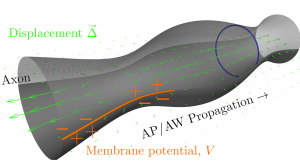By Staff

The action potential is widely understood as an electrical phenomenon. However, a long experimental history has documented the existence of co-propagating mechanical signatures.
In a new paper in the journal Nature Communications, two Princeton University researchers have proposed a theoretical model to explain these mechanical signatures, which they term “action waves.” The research was conducted by Ahmed El Hady, a visiting postdoctoral research associate at the Princeton Neuroscience Institute and a postdoctoral fellow at the Howard Hughes Medical Institute, and Benjamin Machta, an associate research scholar at the Lewis-Sigler Institute for Integrative Genomics and a lecturer in physics and the Lewis-Sigler Institute for Integrative Genomics.
In the model, the co-propagating waves are driven by changes in charge separation across the axonal membrane, just as a speaker uses charge separation to drive sound waves through the air. The researchers argue that these forces drive surface waves involving both the axonal membrane and cytoskeleton as well as its surrounding fluid. Their model may help shed light on the functional role of the surprisingly structured axonal cytoskeleton that recent super-resolution techniques have uncovered, and suggests a wider role for mechanics in neuronal function.
Ahmed El Hady & Benjamin B. Machta. Mechanical surface waves accompany action potential propagation. Nature Communications 6, No. 6697 doi:10.1038/ncomms7697

You must be logged in to post a comment.